Annals of Neurosciences, Vol 14, No 3 (2007)
Annals of Neurosciences, Volume 14, Issue 3 (July), 2007
NEUROPROTECTIVE EFFECTS OF ASPARAGUS RACEMOSUS LINN ROOT EXTRACT: AN EXPERIMENTAL AND CLINICAL EVIDENCE
Corresponding author:
Dr. M. Bhatnagar,
Professor and Head,
Dept of Zoology, University College of Science,
M.L.Sukhadia University, Udaipur-313001, India
Email:
Abstract
Neuroprotective effects of the root extract of Asparagus racemosus were studied both in animal models and clinical patients. Swiss albino mice were used for the study. Mice were subjected to 3 hrs unpredictable swim stress daily up to 30days to develop region specific neurodegeneration (Shukla, 2000). Separate group of animals were given 100mg/kg BW dose of Aracemosus root extract daily up to 30 days, orally. Histological and behavioural studies ( open field test and passive avoidance test ) were carried out. For clinical study , registered patients both male and female of approximately similar age groups, for cognitive disorders at local Ayurvedic hospital were selected. These were subjected to memory retention and recall test. Cytological studies demonstrated that total normal cell count in various regions of hippocampus (CA1, CA3, CA4 and Dg) was significantly high in stress + extract group as compared to stress group and was comparable to control group. Percentage of hippocampal cell degeneration in stress and treated groups observed in our study is ranked in following order -CA3> Dg>CAl>CA4 as compared to control. Increase in normal cell percentage observed in stress+dose group suggests neuroprotection in following order: Dg>CA4>CAl >CA3.
Key words: Asparagus racemosus, Hippocampus, Mice, Clinical study, Root extract.
Introduction
In mammalian brain hippocampus is centre for control of hypothalamic-pituitary adrenal axis (HPA) and is vulnerable to stress stimuli, which affects behaviour, memory and learning (1). Cell loss in hippocampal sub regions have been reported due to exposure to acute or chronic stress, trauma, ischemia (2) or external factors like heat, cold and even social stress (3,4), also in normal ageing and age related disorders. (5) reported that glucocorticoids secreted during stress cause neuronal degeneration in hippocampus. It has been shown that loss of cells in hippocampus affects cognitive functions, memory, learning and also results into age related neurodegenerative disorders (6).
Earlier studies have shown that most of the nervous system disorders from simple dementia to Parkinson's, Alzheimer's etc. are characterized by nerve cell loss in specific brain areas, such as hippocampus, substantia nigra, cerebral cortex etc. Pyramidal cell loss in CA3and CA4 areas of hippocampus (3–5; 7–10) or granule cell loss in dentate gyrus (11) and dopaminergic cell loss in SNc (12) have been shown by many researchers after exposure to specific long term stress and also due to aging. Atrophy of dendrites of CA3 pyramidal neurons (13) associated with impairment in memory has been demonstrated. These changes are not permanent but can return to pre stress condition following rehabilitation for a period of 45 days. However, the structural changes could be permanent when the stress is severe and sufficiently long lasting (14).
Attempts have been on in various laboratories to use plant extracts and bioactive molecules obtained from the plant parts to either halt or prevent the neuron cell loss in brain areas, with a view that synthetic drugs or surgical methods in use are expensive and have many side effects. Plants or plant products used as rasayana in ayurvedic traditional system in India are basically considered as safe, effective, cheaper and without side effects. In India “Medhya Rasayana” is a group of herbal preparations known for their effect on nervous system. Some of them viz. Shankhpushpi (Evolvulus alsenoids), Brahmi (Baccopa monniera), Ashwagandha (Withania somnifera), Jyotishmati (Celestrus peniculalatus) are said to improve mental disabilities, learning and memory. Although these drugs are claimed to improve nervous debilities but there are no experimental or clinical evidences. Recently Tohda (15), Bhatnagar et al., (16), Shukla et al., (17) and Jain et al., (18) have shown neuroprotective effects of certain plant extracts (W. somnifera, S.anacardium, E.alsenoids) in rat model for experimental neurodegeneration induced by giving specific stress or neurotoxic agents like kianic acid, isotonic acid, glutamate etc. These studies demonstrated significant reduction in neurodegenerative cells in hippocampal sub regions of animal model after treatment with plant extracts for specific period.
Asparagus racemosus (Shatawari) is a perennial ornamental plant classified as rasayana in Ayurvedic system. Its succulent roots are used as tonic especially during pregnancy, gynecological disorders like menorrhagia and to promote lactation (19,20). Plant is reported to contain glycosides, diosgenin, cytoesterol and stigmaesterol (21). Presence of isoflavones have proven in Aracemosus (22,23). Govil,(24), Guhabakshi et al (25) also described A. racemosus as a rejuvenator and nervine tonic but its effect on nervous system have not been explored experimentally so far. Present study aim to investigate its effects on CNS, in particular neuroprotective properties experimentally as well as clinically.
Materials and Methods
Adult Swiss albino mice of in breed strain were used for the present study. (Body Weight 35±5 gms.). After receiving them from the supplier, mice were housed in polyutherine cages for one week to acclimatize the laboratory conditions. All the mice were given food and water ad-libitum and were maintained on 12:12 hour light and dark cycle at 27±2°C. Prior to start of the experiment animals were divided into Control (C) and Experimental groups (E) using random number table. All protocols were approved by institutional ethical committee under provisions of CPCSEA( Registration No. 973/9c/06/CPCSEA).
Mice (n=8) of control group were kept in a isolated room and were provided enough food and water for two days. Room was locked for 24 hours. This exercise was performed to maintain nonstress condition and to avoid any stress may develop in these animals due to noise or handling.
Experimental group mice were divided into three experimental groups (n=7) E1, E2 and E3. Mice in E1 group were given 3 hours swim stress daily for 30 days, E2 group mice were given methanolic extract A. racemosus root (100mg/Kg of BW) daily. After one hour of extract dose, they were given three hour swim stress. Animals in E3 group were given extract only (100mg/ Kg.of BW). All treatments were continued for 30 days.
All the animals of E1and E2 group were subjected to swim stress. For this animals were forced to swim for 3 hours specifically between 9:00–11:00 AM in luke warm water ranging from 20±5°C daily for 30 days. Colonic/Rectal temperature was measured everyday immediately before and after stress regimen and other hyperactivities were also recorded e.g. prostration, salivation etc. Besides this daily record of food and water intake was also maintained for all the animals.
The fresh roots of A. racemosus were obtained from university medicinal plant nursery and air dried in shaded condition. Dried roots were minced and powdered. Powder was packed in high quality filter paper for preparation of extract by continuous extraction method using methanol as solvent with the help of Soxhlet extractor. After vacuoevoporation, powder was dissolved in CMC for dose preparation. Mice were given a daily dose of 100 mg/Kg of BW. Dose was administered orally (using feeding tube).
After completion of experiments, mice were killed by decapitation, their brains were dissected out and fixed in 10% neutral chilled formalin for 18 hours at 4°C. After dehydration brains were passed through graded series of alcohol. They were cleared in xylene and were embedded in paraffin wax. Serial sections of 10μm were cut on rotary microtome. Coronal sections containing hippocampal sub regions (Bregma level -2.3 mm to -3.8 mm) dewaxed in xylene, passed through descending alcohol series and hydrated. They were stained in 1% cresyl violet stain, dehydrated in ascending graded alcohol series, cleared in xylene and sections were cover slipped in DPX.
Quantitative analysis of degenerating cells in the pyramidal cell layer of Ammnon's horn and granular cell layer of Dentate Gyrus of hippocampus was carried out with image analysis program. Serial sections passing through hippocampus (bregma level -2.3 to -3.8 mm ) in each brain was used for counting the neuron cell bodies. For cell count in each sub regions five representative areas were selected. Cell count was done automatically in each area and mean of five values was obtained. Cells demonstrating multipolar or bipolar neuron characteristics including clear cytoplasm and distinct nucleus (with one or two nucleolus) were only counted. Darkly stained, shrinked and cells with fragmented nuclei were considered as degenerating cells. Cells exhibiting pyknotic morphology were also included in the counting. Mean values of actual cell count of normal and degenerating cells was calculated separately. Standard deviation from the mean values, standard error of mean was calculated and significance of the result was analyzed with student's t test.
In a separate group (n=6) of control and experimental groups, profile of behaviour activity of each mouse was recorded at 30 min after placement in the activity cage for a period of 10 min. In stress group animals were placed in activity meter immediately after the completion of the stress regimen.
The mice of control and experimental group were also subjected to passive avoidance test (26). The passive avoidance test was studied by a computerized shuttle box. The box is comprised of two compartments. The transfer of mice from one compartment to another was recorded in control and experimental groups, 30 min after the completion of the stress regimen (1st trial) and after 24 hrs ( 2nd trial). The criterion from improved cognitive activity was taken as an increase in the TLT (transfer latency time). On 2nd trial as compared to 1st trial.
Total 16 clinical out patients of a local ayurvedic hospital for known stress related disorders i.e., Patients under going treatment for memory deficits, cognitive changes were selected for this study with prior permission of the authorities. For control studies, a group of fifteen persons were selected by a pre test for the study and as per practitioner's selection. Healthy persons of both sexes and similar age groups were allowed to volunteer for the study. ). Volunteers were selected according to their age, sex and educational status ( include both literate and illiterate ). In each group at least five volunteers selected were illiterate. Both control and patient volunteers were explained related aspects of drug and test to be conducted with out explaining them the real purpose of the tests prior to start of the experiment. Test was conducted everyday between 10 AM to 12 PM after one hour of drug intake in all the four groups. Persons of both sexes were separately divided into Control (C1), stress group (ES1), Stress + Dose group (ES2) and dose group (ES3)
Tests were designed keeping the educational status of the volunteers with the help of Department of Psychology, M.L.S.University, Udaipur. Literate persons in all groups were given test papers in Hindi or English language according to their preference. Illiterate persons in all groups were given pictures of articles, animals, birds, specific scenes for testing memory status. English and Hindi word list including nouns were taken from paper of Yuile and Madigan (27).
Each volunteer in both control and experimental groups was given a list of 20 words and made to read aloud for 30 seconds one by one. These words were recalled by the person in 1 minute time period. Number of words recalled was noted. After each trial a set of 10–15 words or pictures were given as distracters, to avoid learning word list. 5 trials were made to find out the effect of repetition on long term retention. Percent value of word recall is calculated for each person and each trial. Mean value, standard deviation, standard error of mean was calculated for all groups in both sexes. Student `t' test was used to analyze the results.
Results
Animal Study:
Cytological observation:
Light microscopic cytological examination of the neuron cell bodies in the hippocampal sub layers (CA1-CA4 & Dg) of control and experimental rats were performed. Identification of hippocampal sub regions was based on “Rat brain in stereotaxic co-ordinates” atlas by Paxinos and Watson (28). Cell counting study showed that Counting of normal and degenerated cells (Dark cells, cells with cromatolysis, apoptotic bodies, low cytoplasm etc) in control, stress and stress+ extract treated group in CA1, CA2,CA3,CA4 and Dg demonstrate that there was a significant decrease in number of normal cells in stress group as compared to control and stress+extract treated group in Ca1, Ca3, CA4 and Dg. In CA2 no significant change in these numbers was observed. Percentage of hippocampal cell degeneration in stress and treated groups observed in our study is ranked in following order -CA3 > Dg> CA1 > CA4 as compared to control. Increase in normal cell percentage observed in stress+dose group suggests neuroprotection in following order: Dg>CA4> CA1 >CA3. Data are summarized in Figure 1–5.
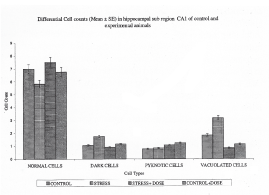
Fig. 1: Differential Cell counts (Mean ± SE) in CAI hippocampal subregion.
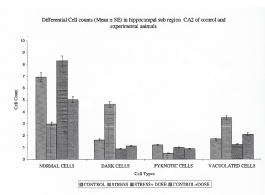
Fig. 2: Differential Cell counts (Mean ± SE) ih CA2 hippocampal subregion.
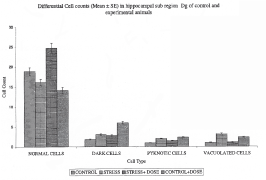
Fig. 3: Differential Cell counts (Mean ± SE) in CA3 hippocampal subregion.
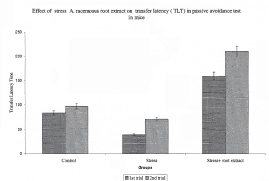
Fig. 4: Differential Cell counts (Mean ± SE) in CA4 hippocampal subregion.
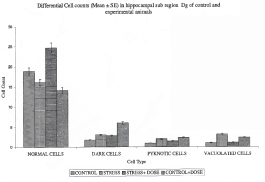
Fig. 5: Differential Cell counts (Mean ± SE) in Dg hippocampal subregion.
Behavioural observation:
No significant change was observed on behavioural locomotor activity profile between the control, stress+extract treated group and stress group at 30 min. The activity counts ( mean±SEM) for control and stress+extract treated group were 141±11 and 139±27 respectively. In stress group the activity count decrease significantly to 98±22.
In passive avoidance test both control and stress+ extract treated groups showed significant increase in learning. A significantly high TLT value (mean+SEM) 159±73.2 and 210±23.5 on 2nd trial from 1st trial, 84±16.4 and 98±18.4 in control and stress+extract treated group respectively. In stress group learning was significantly decreased (39±12.2 and 71±11.42nd trial to 1st trial respectively) Data are summarized in Figure 6.
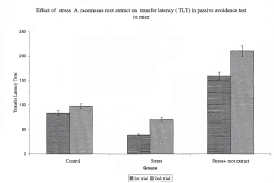
Fig. 6: Effect of stress A. racemosus root extract on transfer latency (TLT) in passive avoidance test in mice.
Clinical study:
Clinical study of both control, stressed and extract treated patients showed a very significant increase in test score of extract treated patients as compared to stress group patients. Results also demonstrate that extract treatment upto third week significantly increase the test score. Data are summarized in Figure 7.
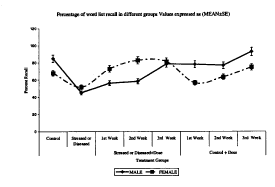
Fig. 7: Mean percentage of score in world recall test.
Discussion
Experimental study in animals and clinical study in patients clearly demonstrates neuroprotective effects of A. racemosus root extract. Differential counting of degenerating cells (dark cells, cells exhibiting peripheral or central chromatolysis, cells with low cytoplasm, apoptotic bodies, vacuolated cytoplasm) in experimental groups (Stress and Stress + dose group) as compared to controls have demonstrated significant decrease in degenerating cells in CA3 and CA4 and Dg sub regions of hippocampus of mice received drug extract as well as stress. Behavior observations such as open field test and passive avoidance test also demonstrates significant increase in activity score of drug treated stressed rats as compared to only stressed and control mice. Further, study performed in patients under strict control of a ayurvedic physician has also shown significant improvement in retention and recall of the memory after treatment with the drug extract. This inference is based on significant change observed i.e., gradual increase in score of the volunteers from first week to third week of the treatment with the extract. Results of the study thus suggest that Asparagus root extract could be an alternative treatment for cognitive disturbances.
Application of herbal preparations as antistress and cytoprotective agent has been attempted by large number of researchers. Sugaya et al., (29) demonstrated cytoprotective action of TJ-960 (an herbal mixture) against cytochalasin-B induced distortion of neurite extension. Sugaya et al., (30) also demonstrated protection of hippocampal neurons against cobalt stress with TJ-960. Bhatnagar et al., (16) and Jain et al., (18 ), Bhatnagar et al (31–33) demonstrated the significant reduction in neurodegenerative cells in hippocampal sub regions after treatment with Evolulus alsenoid and Withania somnifera and A.racemosus root extracts in animal model of specific hippocampal neurodegeneration. Recent in vitro and in vivo studies (unpublished reports) in this laboratory have also substantiated these observations.
A. racemosus root extract is described as a rejuvenator, adaptogenic and nervine tonic especially for females (24,25,34), which increases the life span and delay aging by antagonizing the degenerating changes associated with aging. Isoflavones isolated from Asparagus extract has been shown to possess an estrogenic activity and now recognized as rich source of phytoestrogens (22, 23). Earlier studies supports the action of estrogen in preventing the cellular apoptosis in different tissues including nervous tissue both in vitro and in vivo systems (35–39). It has been demonstrated that cerebrovascular stroke and neurodegenerative disorders are most frequently seen in males than females. Less occurrence of these disorders in females are attributed to the presence of estrogen (40). The increase in dendritic spine formation and arborization in hippocampal area and axonal sprouting of a motor neurons has been also reported after estrogen treatment (41). Up regulation of the expression of mRNA for NGF; IGF-lá, BDNF & TRK-A has been also demonstrated (40). Thus estrogen modulates the synthesis and action of neurotrophins and other factors which control the synaptic plasticity and synaptic functions, probably in result slows down the progression of neurodegenerative changes. These findings may have important implications for the effective use of phytoestrogenic activity not only in maintenance of neuronal functions but also as a neuroprotective agent against various neurodegenerative disorders. Thus significant reduction of neurodegenerative cells after extract treatment and recovery of behavioral deficits in animal models as well as cognitive disturbances in human patients observed in present study could be implicated to phytoestrogenic component of the Asparagus.
This study first time describes the influence of A. racemosus root extract on a subjective trial in human volunteers suffering from various cognitive disorders such as memory deficit and memory disturbances. Stress influences cognition in both animals and humans is well established. Stress induced release of glucocorticoids (GC's; Corticosterone in rats, Cortisol in humans) are among other factors like epinephrine or CRH which are responsible for these effects. Study in rodents have revealed that GCs enhance or impairs performance dependent on the specific memory type tested and on the timing of the stress exposure, respectively (42–46)). Experimental studies in humans have repeatedly shown that GC administration can interfere with performance in working memory as well as declarative memory tasks, (47–52) and delayed recall of declarative material (51,52). Memory impairing effects have been also observed in young and elderly subjects after exposure to psychosocial laboratory stressors (44, 48, 53)). Prolonged treatment (several days) seems to be needed in order for declarative learning deficits to occur (49,54–56). Gender plays an important role in the effects on cognition (57). In humans, an epidemiological study observed that higher basal Cortisol levels were associated with poorer memory in elderly women, but not in men (58). The stress-induced Cortisol increase was negatively correlated with the memory performance after cessation of the stressor (48,59 ). In the present study it was observed that the females show less effect of stress on short term memory than males. This also provides a clue that estrogen also plays a vital role in cognition (60). Besides this estrogen is a established neuroprotective agent, a finding that propelled many researchers to find a breakthrough or sidetrack for the protection from cerebrovascular diseases and neurodegenerative diseases (61–69)
Current study provides a clear evidence for association between stress induced Cortisol elevations and memory performance after cessation of stress and effect of the Shatawari extract on the patients. In addition it establishes that drug is more useful for females but also act favorably for males if taken continuously for longer periods, although to a less but significant extent as now the emerging role of exogenous estrogen exposure in male fertility is well established and it was also suggested that in this local context, estrogenic substances should also be considered “male hormones” (70,71).
In conclusion the present study demonstrate neuroprotective effects of Asparagus racemosus root extract as observed in experimental animals as well as human subjects and that such CNS active properties may be due to the presence of phytoestrogenous.
References:
1. De kloet ER, Sutanto W, Rots N,Van Harst A, et al; Plasticity and functions of brain corticosteroid receptors during aging. Acta Endocrinol. 1991; 125 : 65–72.
2. Rosenbaum DM, Michaelson M, Batter DK, Doshi P et al; Evidence for hypoxia -induced programmed cell death of cultured neurons. Ann Neurol. 1994; 36: 864–70.
3. Uno H, Tarara R, Else JG, Suleman MA ,et al; Hippocampal damage associated with prolonged and fatal stress in primates. J Neurosci. 1989; 9: 1705–11.
4. Sharma HS, Navarro JC, Dey PK Acute heat exposure causes cellular alteration in cerebral cortex of young rats. Neuroreport 1991 2: 155–58.
5. Sapolasky RM, Krey LC, Mc Ewen BS Prolonged glucocorticoid exposure reduces hippocampal neuron number: implications for aging. J Neurosci. 1985; 5: 1222–7.
6. Jarrard LE On the role of the hippocampus in learning and memory in the rat. Beh Neuro Biol.1993; 60: 9–26.
7. Kerr DS, Campbell IW, Applegate M, Bredish A et al; Chronic stress induced acceleration of electrophysiologic and morphometric biomarkers in hippocampal aging. J Neurosci. 1991; 11:1316–24.
8. Sapolasky RM, Kerry LC, McLewin BS The adrenocortical stress response in the aged male rat: impairment of recovery from stress. Exp Gerontol. 1983;18:55–64.
9. Gould E, Woolbyey C, McEwen S Short term glucorticoid manipulation affect neuronal morphology and survival in dentate gyrus. Neurosci. 1990; 37:367–75.
10. Olanow WC, Grey WA. Metals and free radicals in neurodegeneration. Current Opinion Neurol. 1994; 7 :548–58.
11. Slovitter RS, Anne L, Dean E, Neubort S. Adrenolactomy induced granule cell degeneration in rat hippocampal dentate gyrus. Characterization of an in vivo model of control neuronal death. J Comp Neurol. 1993; 330: 324–36.
12. Adams J, Klaidman, Odunge IN, Slen HC, et al; Alzheimer's and Parkinson's disease: Brain levels of glutathione, glutathione disulphide and vitamin E. Mol Chem Neurol Pathol 1991; 14:213.
13. Watanab Y, Gould E, McEwen BS. Induced atrophy of apical dendrites of hippocampal CA3 pyramidal neurons. Brain Res. 1992; 588:341–45.
14. McEwen B, Gould EA, Sakai RR The vulnerability of hippocampus to protective and destructive effects of glucocrticoids in relation to stress. Br J Psych 1992; 15:18–23.
15. Tohda C, KuboyanaT, Komatsu K Dendrite extension by methanol extract of ashwagandha (roots of W. somnifera)in SK-N-SH cells. Neuroreport. 2000; 11:81–5.
16. Bhatnagar M, Shukla SD, Jain S, Mundra A. Cytoprotective effects of Shankhpushpi and E.alsenoides preparation on hippocampal cells in mice. Ind Drugs 2000; 37 : 280–85.
17. Shukla SD, Jain S, Sharma K, Bhatnagar M. Stress induced neuron degeneration and protective effects of Semecarpus anacardium Linn, and Withania somnifera Dunn in hippocampus of albino rats: an ultrastructural study. Ind J Of Exp Biol 2000; 38:1007–13.
18. Jain S, Shukla SD, Sharma K, Bhatnagar. M Neuroprotective effects of Withania somnifera Dunn in hippocampal sub regions of female albino rats. Phytother Res 2001; 15: 544–48.
19. Patel AB, Kanitkar UK Asparagus racemosus Willd form bordi as a galactogogue in buffaloes. Ind Vet J 1969; 46:718–21.
20. Hemadri KR Leucorrohoea and menorrhagia (Ref.Res.Cont..Ay).Tribal medicine. Ancient Sci Life 1983; 3: 40–41.
21. Asolkar LV, Kaker KK, Chakre OJ. Second supplement to glossary of Indian medicinal plants with active principles. Part-I CSIR 1992; 100–01.
22. Saxena VK, Chaurasia S A new isoflavone from the roots of Asparagus racemosus. Fitotherapia 2001; 72: 307–09.
23. Murkies AL, Wilcox G, Davis SR Phytoestrogens. J Clin Endocrinol. Metab. 1998; 83: 297–03.
24. Govil JN. Concepts of multidiscipline approach to the medical plants. Part 2. New Delhi Vedame Books. 1998; 434.
25. Guha Bakshi DN, Sensarma F, Pal DC. A lexicon of medical plants in India. Calcutta Nyag Prokash. 1999; 205–06.
26. Brioni JD, Hock FJ, McGaugh JJ. Drug effects on learning and memory. In: Voge GH, Voge WH, (Eds.) Drug Discovery and Evaluation: Pharmacological assays. New York Springer Verlag. 1997; 335–6.
27. Yuile, Madigan Concreteness. Imagery and Meaningfulness of 925 nouns. J Exp Psy 1969.
28. Paxonos G, Watson C. The rat brain in stereotaxic coordinates 2nd ed. Florida Acadeic Press. 1986.
29. Sugaya A, Yuzurihara M, Tsuda T, Yasuda K, et al; Normalizing effect of Saiko-Keishi-To commercial formula on cytochalasin-B distorted neuritis using primary cultured neurons of rat cerebral cortex. J Ethenopharmacology. 1987; 21: 193–99.
30. Sugaya E, Ishige A, Sekiquchi K, Yuzurihara T, et al; Protective effects of TJ-960 herbal mixture on hippocampal neuron damage induced by cobalt focus in the cerebral cortex of rats.J Ethnopharmacol. 1991; 34:13–19.
31. Bhatnagar M, Sisodia SS, Bhatnagar R. Antiulcer and antioxidant activity of Asparagus racemosus Willd and Withania somnifera Dunal in rats. Ann N Y Acad Sci. 2005;1056:261–78.
32. Bhatnagar M, Shukla SD, Bhatnagar R Experimental neurodegeneration in hippocampus and its phytoremidation. J Herb Pharmacother.2005; 5 :21–30.
33. Bhatnagar M, Sisodia SS Antisecretory and antiulcer activity of Asparagus racemosus wild against indomethacin plus phyloric ligation-induced gastric ulcer in rats. J Herb Pharmacother 2006; 6:13–20.
34. Kokate CK, Purohit AP, Gokhle SB Drugs containing glycosides: Shatavari. Pharmacognosy; Nirali Prakashan, Pune : 2003; 216–17.
35. Zhong L, Kane DJ Bredesen DE. Bcl-2 blocks glutamate toxicity in neural cell lines. Mol Brain Res. 1993;19: 353–55.
36. Singer CA, Rogers KL, Strickland TM, Dorsa DM. Estrogen protects primary cortical neurons from glutamate toxicity. Neurosci Lett. 1996; 212:13–6.
37. Bresden DE, Rabizadeh S P75 NTR and apoptosis: Trk -dependent and Trk independent effects. Trends in Neurosci. 1997; 7:287–90.
38. Nishino H, Nakajima K, Kumazaki M, Fukuda A,et al; Estrogen protects against while testosterone exacerbates vulnerability of the lateral striatal artery to chemical hypoxia by 3-nitropropionic acid. Neurosci Res. 1998; 30:303–12.
39. Nilson J, Brinton D. Impact of progestins on estrogen induced neuroprotection: synergy by progesterone and 19-norprogesterone and antagonism by medroxyprogestetrone acetate. Endocrinol. 2002; 143: 205–12.
40. Deshpande SB Protective role of estrogen in neurodegenerative disorders. Ind J Physiol Pharmacol. 2000; 44 :43–9.
41. Gibbs RB Estrogen and nerve growth factor-related systems in brain. Effects on basal forebrain cholinergic neurons and implications for learning and memory processes and aging. Ann N Y Acad Sci. 1994; 4: 165–96.
42. Diamond DM, Fleshner M, Ingersoll N, Rose GM. Psychological stress impairs spatial working memory: relevance to electrophysiological studies of hippocampal function. Behav Neurosci.1996; 110: 661–72.
43. Lupien SJ, McEwen BS. The acute effects of corticosteroids on cognition: integration of animal and human model studies. Brain Res Revi997; 24: 1–27.
44. de Quervain DJ, Roozendaal B, McGaugh JL. Stress and glucocorticoids impair retrieval of long-term spatial memory. Nature 1998; 394: 787–90:
45. De Kloet ER, Oitzl MS, Joels M. Stress and cognition: are corticosteroids good or bad guys? Trends Neurosci. 1999; 22:422–26.
46. Roozendaal B Glucocorticoids and the regulation of memory consolidation. Psychoneuroendocrinology 2000; 25: 213–38.
47. Wolkowitz OM, Reus VI, Weingartner H, Thompson K, et al; Cognitive effects of corticosteroids. Am J Psychiatry 1990; 147: 1297–303.
48. Kirschbaum C, Wolf OT, May M, Wippich W et al; Stress-and treatment induced elevations of Cortisol levels associated with impaired declarative memory in healthy adults. Life Sci 1996; 58: 1475–83.
49. Newcomer JW, Selke G, Melson AK, Hershey T, et al; Decreased memory performance in healthy humans induced by stress-level Cortisol treatment. Arch Gen Psychiatry 1999; 56: 527–33.
50. Lupien SJ, Gillin CJ, Hauger RL. Working memory is more sensitive than declarative memory to the acute effects of corticosteroids: a dose-response study in humans. Behav Neurosci 1999,113: 420–30.
51. De Quervain DJ, Roozendaal B, Nitsch RM, McGaugh JL et al; Acute cortisone administration impairs retrieval of long-term declarative memory in humans. 3: 313–314.
52. Wolf OT, Convit A, McHugh PF, Kandii E, et al; Cortisol differentially affects memory in young a.nd elderly men. Behav Neurosci.2001; 115:1002–11.
53. Wolf OT, Kudielka, BM, Hellhammer, DH, Torber S, et al;. Two weeks of transdermal estradiol treatment in postmenopausal elderly women and its effects on memory and mood: verbal memory changes are associated with the treatment induced estradiol levels. Pscychoneuroendocrinol.1999; 24: 727–41.
54. Newcomer JW, Craft S, Hershey T, Askins K, et al; Glucorticoid-induced impairment in declarative memory performance in adult humans. J Neurosci. 1994; 14: 2047- 53.
55. Schmidt LA, Fox NA, Goldberg MC, Smith CC, et al; Effects of acute prednisone administration on memory, attention and emotion in healthy human adults. Psychoneuroendocrinology 1999;24: 461- 83.
56. Young AH, Sahakian BJ, Robbins TW Cowen PJ The effects of chronic administration of hydrocortisone on cognitive function in normal male volunteers. Psychopharmacology 1999; 145: 260- 66.
57. Wood GE , Shors TJ. Stress facilitates classical conditioning in males, but impairs classical conditioning in females through activational effects of ovarian hormones. Proc Natl Acad Sci USA 1998; 95:4066–71.
58. Seeman TE, Me Ewen BS, Singer BH, Albert MS et al; Increase in urinary Cortisol excretion and memory declines: Mc Arthur studies of successful aging. J Clin Endocrinol Metab. 1997; 82: 2458–65.
59. Kirschbaum C, Kudielka BM, Gaab J Schommer NC,et al; Impact of gender, menstrual cycle phase and oral contraceptives on the activity of hypothalamus -pituitary-adrenal axis. Psychosom Med. 1999; 61: 154–62.
60. Carlson LE, Sherwin BB. Relationships among Cortisol (CRT), dehydroepiandrosterone sulfate (DHES) and memory in a longitudinal study of healthy elderly men and women. Neurobiol aging. 1999; 20: 315–24.
61. Dhandapani K, Brann DW. Protective effects of estrsogens and SERMS in brain. Biol Reprod.2002; 67 :1379–85.
62. Hail ED, Pazara KE, Linseman KL. Sex differences in postischemic neuronal necrosis in gerbils. J Cereb Blood Flow Metab. 199.1; 11: 292–98.
63. Simpkins JW, Rajakumar G, Zhang YQ, Simpkins CE, et al;. Estrogens may reduce mortality and ischemic damage caused by middle cerebral artery occlusion in female rats. J Neurosurg. 1997; 87:724–30.
64. Dubai DB, Kashon ML, Pettigrew LC, Ren JM et al;. Estradiol protects against ischemic injury. J Cereb Blood Flow Metab 1998; 18: 1253–58.
65. Shi J, Panickar KS, Yang SH, Rabbani O, et al;. Estrogen attenuates over expression of â-amyloid precursor protein messenger RNA in an animal model of focal ischemia. Brain Res. 1998; 810: 87–92.
66. Zhang YQ, Shi J, Rajakumar G, Day AL,et al; Effects of gender and estradiol treatment on focal brain ischemia. Brain Res. 1998; 784: 321–24.
67. Rusa R, Alkayed NJ, Crain BJ, Traystman Rj et al; 17â-estradiol reduces stroke injury in estrogen deficient animals. Stroke 1999; 30: 1665–70.
68. Toung TJK, Traystman RJ, Hum PD Estrogen-mediated neuroprotection after experimental stroke in males. Stroke 1998;29: 1666–70.
69. Alkayed NJ, Murphy SJ, Traystman RJ, Hum PD. Neuroprotective effects of female gonadal steroids in reproductively senescent female rats. Stroke 2000; 31: 161- 68.
70. O' Donnell L, Robertson KM, Jones ME, Simpson ER. Estrogen and spermatogenesis. Endocr Rev. 2001; 22: 289–318.
71. Robertson KM, O'Donnell L, Simpson ER, Jones ME. The phenotype of the aromatase knockout mouse reveals dietary phytoestrogens impact significantly on testies function. Endocrinology 2002; 143 : 2913–21.
(c) Annals of Neurosciences.All Rights Reserved